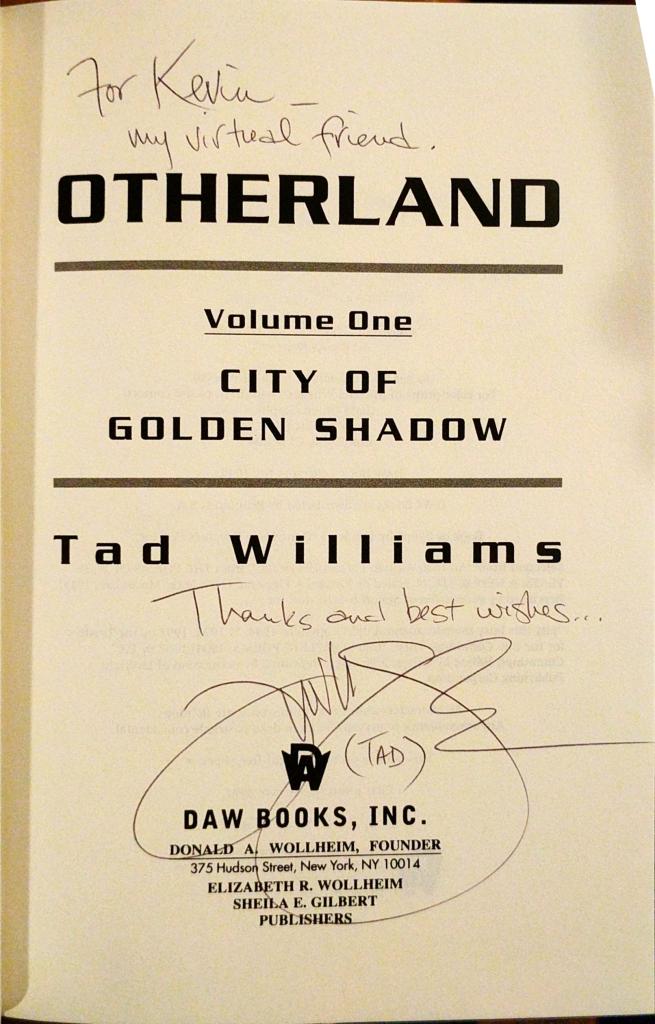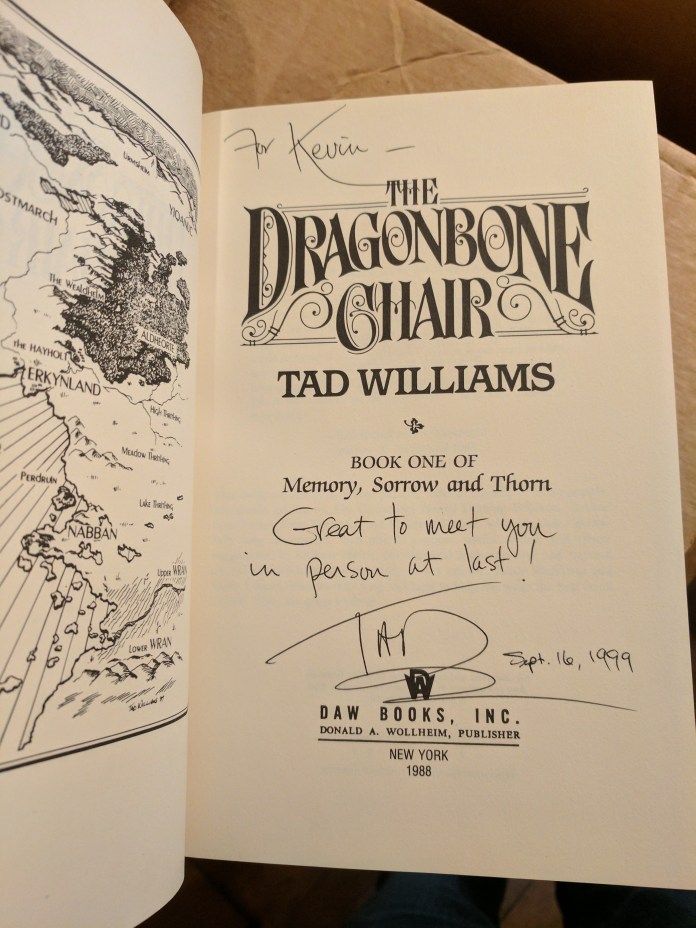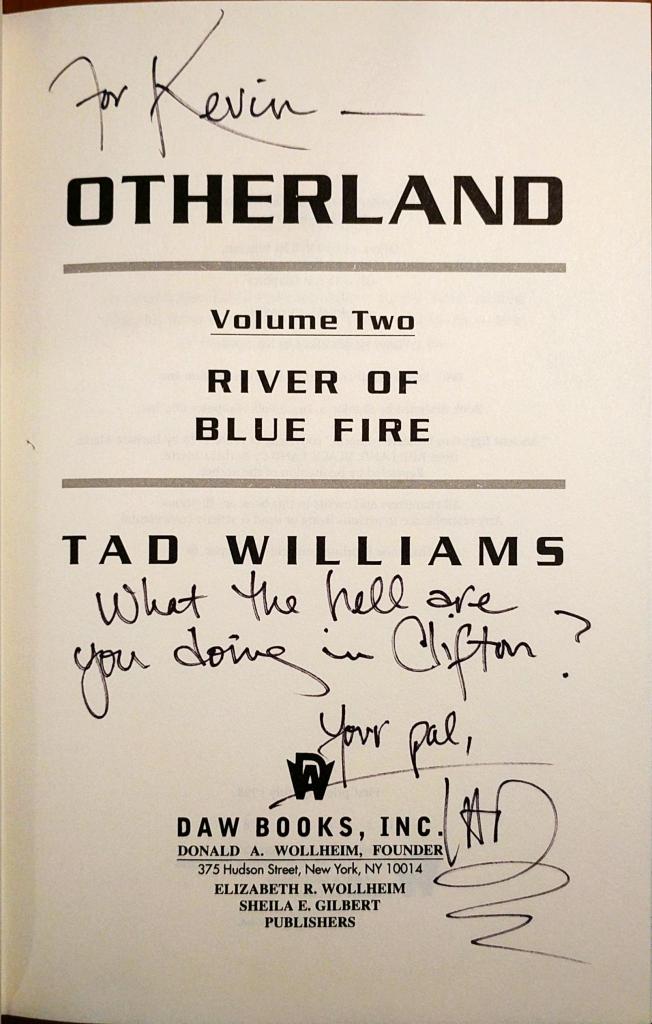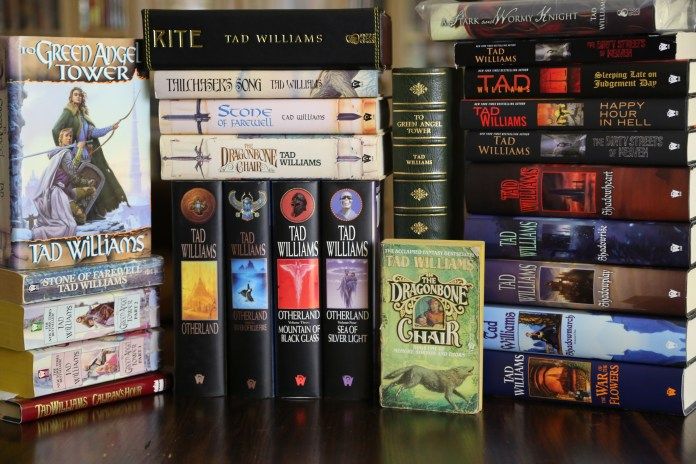
To Osten Ard Again with Tad Williams
On this day of days there is a familiar stirring deep inside the dozing heart of the fantasy world. The realm of Osten Ard comes alive again with the release of Tad Williams’ The Heart of What Was Lost.
For some of us, it’s a day we never expected. For all of us, it is a day to celebrate, a day to explore, and a day to lose ourselves in the beauty and tragedy and horror and history of one of the most beloved lands in fantastical literature.
Discovery
I first discovered Osten Ard in the summer of 1991. I lived in a rural community in north central Illinois, and the only place I could easily buy books was the tiny Waldenbooks at the local mall.
The Fantasy and Sci-Fi section was tucked away in the back of the store, adjacent to Romance, opposite Military History. It was a three foot wide by six foot tall portal into other worlds, and I spent hours on the floor in that aisle reading the opening chapters to countless novels.
I picked up my first Tad Williams’s book simply because Michael Whelan’s cover art beckoned me. I knew I had to own it. I didn’t bother to open it first, which was a mistake. I forked over my money, drove home, and admired my new paperback copy of Stone of Farewell. It wasn’t until I started reading that I realized I’d snagged book two of a trilogy instead of book one. Dammit.
With book one eventually in hand, I read the first chapter on my old bunk beds at my parents’ house. I remember sunlight filtering through the trees in the back yard to make crazy shadows on the wall. And I remember that first sentence, which I plagiarized to start this post:
“On this day of days there was an unfamiliar stirring deep inside the dozing heart of the Hayholt, in the castle’s bewildering warren of quiet passages and overgrown, ivy-choked courtyards, in the monk’s holes and damp shadowed chambers.” Sleepy castles had come to life. Something was about to happen. And with it came a sense of history, mystery, and adventure.
I was sixteen years old, only slightly older than the main character. His name was Simon. He was a lazy castle scullion with few friends, but he was about to be thrust unwillingly into a larger world. It was exactly the type of story I desired. It was also, I believe, the only use of the word “scullion” I’d ever come across.
Most readers can identify a period in life when books began to click, when the magical world of reading welcomed them inside, when they discovered the amazing opportunity to experience lives otherwise unattainable. In the early 90s, I found Tolkien and Terry Brooks and Robert Jordan and Tad Williams, and life has never been the same.
Years later, my ex-wife and I would name our two kittens after fictional princesses. Everyone knew Princess Leia, but most folks scratched their chins when confronted with a name straight out of Osten Ard. Every veterinarian from Seattle to New Jersey to Chicago misspelled the name Miriamele. We were happy to explain its origins.
Virtual Encouragement
In 1996, Tad released the first book of his Otherland series. I was a college student, and I grabbed one of the first copies available at the University Bookstore.
The World Wide Web was in its infancy, but this new Otherland novel had a link to an actual website. This was rare and exciting. Netscape Navigator was the browser of choice in those days. Internet Explorer was just catching on, and Chrome wouldn’t exist for more than a decade. Let’s just say not many people knew what a website was, let alone how to access one.
I went to this Tad Williams website, and I couldn’t believe my eyes when I saw a link to email the author. Surely this wasn’t his actual email address. I clicked it, sent a message into the ether, and expected a response from his publishing company or marketing firm. Of course, the Internet was a different world back then.
I still have the response:
DEAR KEVIN,
I’M HERE, AND I’M DEFINITELY RESPONDING TO E-MAILS. IT MAY BE A LITTLE MORE DIFFICULT WHILE I’M ON TOUR IN THE NEXT FEW WEEKS, BUT I’LL MANAGE SOMEHOW.
THANKS FOR YOUR KIND WORDS. I DON’T BELIEVE THERE’S SUCH A THING AS A USELESS PARAGRAPH, ESPECIALLY WHEN YOU HAVE TO JUSTIFY USING AS MANY OF THEM AS I DO. I HAVE A RULE, WHICH IS THAT EVERY SCENE SHOULD DO AT LEAST TWO THINGS — THAT IS, ADVANCE THE PLOT IN SOME WAY, BUT ALSO GIVE SOME INSIGHT INTO A PLACE OR A PERSON OR A SITUATION.
I’M REALLY GLAD YOU LIKE THE BOOKS, AND THAT YOU BELIEVE IN RE-READING. I TRY VERY HARD TO MAKE SURE THERE ARE THINGS THAT PEOPLE WILL ONLY PICK UP IN THE SECOND OR THIRD READING. ALL OF MY FAVORITE BOOKS ARE LIKE THAT, SO I’VE WORKED AT IT.
I HOPE YOU LIKE OTHERLAND.
BEST WISHES,
TAD WILLIAMS
We would exchange many emails over the next year or two. I don’t have them all, but I kept a few. I can’t overstate the impact they had. As a dorky, shy, introverted kid mired in self-doubt who had switched majors from Architecture to Creative Writing (sorry, Mom), the insights from an admired author were the stuff of dreams.
Here are some of my favorite excerpts from his emails, all from 1996 and 1997:
On books:
I’M PRETTY CAREFUL WITH MY BOOKS, TOO. I HAD TO LIVE WITHOUT MOST OF THEM FOR THREE YEARS WHILE I WAS IN ENGLAND (TOO EXPENSIVE TO SHIP) AND IT ALMOST KILLED ME.
On revisions:
I THINK IT’S BEST TO DO ONLY MINOR REVISIONS UNTIL YOU’VE GONE THROUGH THE WHOLE THING ONCE. OTHERWISE, IT’S EASY TO LOSE FLOW AND RHYTHM. THAT’S JUST MY WAY, BUT I THINK THERE’S SOME VALUE TO IT. BEGINNING WRITERS HAVE A TENDENCY TO GO OVER AND OVER THE SAME BITS UNTIL THEY’VE SQUISHED THE JUICE OUT OF THE WORK.
On flying:
AS LONG AS THE PLANE TAKES OFF AND LANDS SAFELY, I DON’T CARE IF THERE IS A BLIZZARD ON THE GROUND OR HAILSTONES THE SIZE OF VOLLEYBALLS. (I’M NOT A GOOD FLYER.)
On the value of readers as motivation:
I’M GLAD YOU’RE ENJOYING THE BOOK. I’M WRESTLING WITH THE NEXT VOLUME, AND IT’S NICE TO KNOW PEOPLE WANT TO READ IT WHEN ONE IS STRUGGLING WITH THE DIFFICULT STUFF (OR JUST HAVING A BAD CASE OF THE DON’T-WANT-TO-WORKS.)
On computers:
MY OLD MACINTOSH II, WHICH WAS BEING USED BY OUR TENANT IN LONDON, FINALLY DIED, SO I’M HAVING HER BUY A NEW COMPUTER. TALK ABOUT OLD: THE MAC II WAS OFFICIALLY MADE OBSOLETE BY 1989 OR SO, I THINK. AH, WELL — YOU CAN’T REALLY AFFORD TO TRY TO KEEP UP WITH THINGS CHANGING SO FAST. GO FOR FUNCTIONAL, THAT’S WHAT I SAY.
And the one I took most to heart over the years:
HOPE THE WORK ISN’T GETTING YOU DOWN TOO MUCH. YOU’RE GOING ABOUT IT THE RIGHT WAY, IT SOUNDS LIKE. BUT DON’T GO BACK OVER THE SAME BIT TOO MANY TIMES — IT’S MORE IMPORTANT TO FINISH SOMETHING, THEN DO THE MAJOR REWRITING.
I struggle to this day with constant revision instead of finishing a draft. I want tone and mood and language to be perfect, especially at the beginning of a story when it matters most. I equate it to finding the proper location and lighting for the opening scene of a movie.
Of course, what I’ve come to realize is that my so-called perfectionism is really a disguise for procrastination. Creating is difficult. It’s much less scary to fix something you’ve already written than to write the next chapter and commit to a direction. Sure, editing is a bitch, and cutting words is difficult. Perhaps that’s why this post is so damn long. But creating the story, the scenes, the setting, the sentences… The actual act of writing… That’s the hard stuff. I constantly remind myself of Tad’s words, and I try to remember to finish before tinkering for too long.
My daughter likes to write stories. She’s begun many. I always suggest she try to finish at least one of them. “You’ll never learn to write a full arc if you only ever write beginnings.” As with most parental advice, it’s far easier to give than to follow. We’re both practicing.
Anyway, I was always impressed and amazed that Tad remembered our conversations. This was before social networks, before you could spam an author’s Facebook wall or MySpace page to get their attention. After our first email, I sent my sister to get a book signed because I was out of town, he signed it thusly:

Years later, after I’d moved from Illinois to Seattle to Clifton, New Jersey, I finally met him in person at a Barnes & Noble. I didn’t think he’d remember me, but he did, and his response was priceless.


To this day, it makes me laugh. You’re a great human being, Mr. Williams. And I thank you.
To Green Angel Tower
Book 3 of Memory, Sorrow, and Thorn (the name of the original Osten Ard trilogy) is titled To Green Angel Tower. It was a beast. The hardcover was the biggest book I owned at the time, and it may be the fattest novel I own to this day. 1100 pages of finely printed text. 520,000+ words. Wikipedia claims its one of the biggest novels ever published in a single volume (and it had to be published as two paperbacks). In the days before Kindles, this thing was brutal. But it was gorgeous.
I remember the day it arrived at Waldenbooks. The publishers released two versions of the dust jacket. My naively egocentric teenage self had no doubt they did it solely to torment me and my empty wallet.
I chose the copy with Simon on the cover, and I took it with me everywhere. I loved the story arcs. I loved that a few tedious aspects of the first book (those damn tunnels) played important roles in the final volume. I loved that I couldn’t predict the climax, and I cried at last chapter reunions.
This is what a good book should do to you. This is how you create an emotional adventure that culminates, after all those words and pages, with a sense of nostalgia shared by both characters and readers alike. We were all different when the story began, and those of us who survived the journey can celebrate the accomplishment together. Wait, is that too cheesy? I don’t care, because this is where I get to tell you about my awesome edition of the book.
A non-profit group called The Pixel Project runs a fundraising campaign they call “Read for Pixels”. Their effort brings popular authors together with fans through online video chats/readings/Q&As to fight violence against women. Authors offer services or books or character names as a way to earn donations for the charity.
Last year, Tad Williams participated. He hosted a live Google Hangout and offered up several items. I was immediately drawn to the leather bound hardcover edition of To Green Angel Tower given to him by his UK publisher. I believe the original plan was to produce a limited run of these collectibles, but it never happened. This was a one-of-a-kind prototype. Signed by the author. And I thanked the gods my wallet wasn’t as empty as it had been all those years earlier at Waldenbooks.
I bought the book for three obvious reasons. 1) I’m a huge fan, as evidenced above. 2) The proceeds went to a good cause. And, most importantly, 3) This was a book that greatly shaped my creative life, signed by the author who did the same. It was a chance to own a treasure that represented so much more than your typical collectible book. And I’m thrilled to own it. Note: If I was Tad, I’d have never given it up. If he wants it back, he can have it eventually. I want to admire it for a bit longer.

The Heart of What Was Lost
Thus we arrive once more at today. The newest Osten Ard novel hits shelves twenty-three years after To Green Angel Tower, and the story takes place five years after the events of that previous book. It’s a novella, which by Tad’s wordcount standards equates to a short 225 pages. I believe it’s meant to set the scene for a new trilogy, The Last King of Osten Ard, which arrives this June with the release of book one, The Witchwood Crown.
That’s all I know about it. If it sounds like a marketing blurb, that’s because I read it in a marketing blurb. I’ve mostly stayed away from descriptions and spoilers and reviews. I’ll know more shortly. I have a copy on hold at the bookstore and another copy waiting on my Kindle.
I reread the Memory, Sorrow, and Thorn trilogy about a year ago, knowing new books were on the way. It was every bit as delightful as I remembered. Like Simon, I fell in love. I grew up a bit. And I cried at the end. The story hits every note, and they all tug fiercely at the heartstrings when you toss in a bit of middle-aged sentimentality and nostalgia.
I had worried the books might not hold up to memory. I worried I’d been telling people for years to read what my older self couldn’t believe my younger self loved. My worries were unfounded. Some books stay with us forever. They’re usually pretty good. This was no exception. I should have known. I’ve read all Tad’s books since then. His Otherland series is brilliant, and it has some of the most epic and unforgettable scenes I’ve ever read. I strongly encourage anyone to read anything he’s ever written. You’ll be glad you did.
As for me, I’ll probably like the new book even if it sucks. Thankfully, nothing I’ve read by Tad has ever sucked.
So grab some coffee and return with me to Osten Ard. Adventure and excitement await. As I’m sure do heartache, sadness, pain, fear, and tortuous trials of good and evil. C’mon. If it was all rainbows and roses, it wouldn’t be nearly as fun.

Also published on Medium.